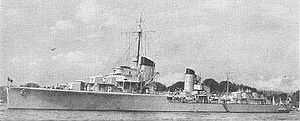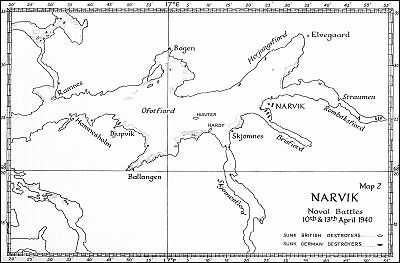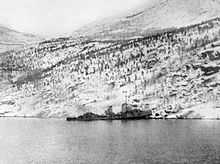German destroyer Z2 Georg Thiele
 Leberecht Maass, sister ship of the Georg Thiele | |
| Career (Nazi Germany) | |
|---|---|
| Name: | Georg Thiele |
| Namesake: | Georg Thiele |
| Ordered: | 7 July 1934 |
| Builder: | Deutsche Werke, Kiel |
| Laid down: | 25 October 1934 |
| Launched: | 18 August 1935 |
| Commissioned: | 27 February 1937 |
| Identification: | Z2 |
| Fate: | Beached, 13 April 1940 |
| General characteristics | |
| Class and type: | Zerstörer 1934 |
| Displacement: | 2,171 tonnes (2,137 long tons) |
| Length: | 119 m (390 ft 5 in) o/a 114 m (374 ft 0 in) w/l |
| Beam: | 11.3 m (37 ft 1 in) |
| Draft: | 4.23 m (13 ft 11 in) |
| Installed power: | 70,000 shp (52,000 kW) |
| Propulsion: | 2 shafts, 2 × Wagner geared steam turbines 6 × water-tube boilers |
| Speed: | 36 knots (67 km/h; 41 mph) |
| Range: | 1,825 nmi (3,380 km; 2,100 mi) at 19 knots (35 km/h; 22 mph) |
| Complement: | 325 |
| Armament: | 5 × 1 - 12.7 cm (5 in) guns 2 × 2 - 3.7 cm (1.5 in) guns 6 × 1 - 2 cm (0.79 in) guns 2 × 4 - 53.3 cm (21 in) torpedo tubes 60 mines 32–64 depth charges, 4 throwers and 6 individual racks |
| Service record | |
|---|---|
| Commanders: | Max-Eckart Wolff |
The German destroyer Z2 Georg Thiele was a Type 1934 destroyer built for Nazi Germany's Kriegsmarine in the mid-1930s. She was named after Lieutenant Commander (Korvettenkapitan) Georg Thiele who commanded the Seventh Half Flotilla of torpedo boats in the Battle off Texel in October 1914.[1] At the beginning of World War II, the ship was initially deployed to blockade the Polish coast, but she was quickly transferred to the German Bight to lay minefields in German waters. During the early stages of the Norwegian Campaign, Georg Thiele fought in both naval Battles of Narvik and had to be beached to allow her crew to abandon ship safely after she had been severely damaged by British fire.
Design and description
Georg Thiele had an overall length of 119 meters (390 ft 5 in) and was 114 meters (374 ft 0 in) long at the waterline. The ship had a beam of 11.3 meters (37 ft 1 in), and a maximum draft of 4.23 meters (13 ft 11 in). She displaced 2,223 long tons (2,259 t) at standard load and 3,156 long tons (3,207 t) at deep load. The Wagner geared steam turbines were designed to produce 70,000 shaft horsepower (52,199 kW) which would propel the ship at 36 knots (67 km/h; 41 mph). Steam was provided to the turbines by six high-pressure Wagner boilers[2] with superheaters. Georg Thiele carried a maximum of 752 metric tons (740 long tons) of fuel oil which was intended to give a range of 4,400 nautical miles (8,100 km; 5,100 mi) at 19 knots (35 km/h; 22 mph), but the ship proved top-heavy in service and 30% of the fuel had to be retained as ballast low in the ship.[3] The effective range proved to be only 1,530 nmi (2,830 km; 1,760 mi) at 19 knots (35 km/h; 22 mph).[4]
The ship carried five 12.7 cm SK C/34 guns in single mounts with gun shields, two each superimposed, fore and aft. The fifth gun was carried on top of the rear deckhouse. Her anti-aircraft armament consisted of four 3.7 cm SK C/30 guns in two twin mounts abreast the rear funnel and six 2 cm C/30 guns in single mounts. The ship carried eight above-water 53.3-centimeter (21.0 in) torpedo tubes in two power-operated mounts.[2] Four depth charge throwers were mounted on the sides of the rear deckhouse and they were supplemented by six racks for individual depth charges on the sides of the stern. Enough depth charges were carried for either two or four patterns of 16 charges each.[5] Mine rails could be fitted on the rear deck that had a maximum capacity of 60 mines.[2] A system of passive hydrophones designated as 'GHG' (Gruppenhorchgerät) was fitted to detect submarines.[6] The crew numbered 10 officers and 315 men, plus an additional four officers and 19 enlisted men if serving as a flotilla flagship.[2]
Service history
The ship was ordered on 7 July 1934 and laid down at Deutsche Werke, Kiel, on 25 October 1934 as yard number K243. She was launched on 18 August 1935 and completed on 27 February 1937.[7] Georg Thiele was assigned to the 1st Destroyer Division on 1 December 1937[1] and made a port visit to Ulvik, Norway in April 1938, together with her sisters Z3 Max Schultz and Z4 Richard Beitzen. Upon her return she was taken in hand by Deutsche Werke to have her bow rebuilt to reduce the amount of water that came over the bow in head seas. This increased her length by .3 meters (1 ft 0 in). The ship participated in the 22 August Fleet Review for Adolf Hitler and Miklós Horthy, Regent of the Kingdom of Hungary, and the following fleet exercise.[8] In December, Georg Thiele, together with her sisters Z3 Leberecht Maass, Max Schultz, and Richard Beitzen, sailed to the area of Iceland to evaluate their seaworthiness in a North Atlantic winter with their new bows. On 23–24 March 1939, the ship was one of the destroyers that escorted Hitler aboard the pocket battleship Deutschland to occupy Memel.[1] She participated in the Spring fleet exercise in the western Mediterranean and made several visits to Spanish and Moroccan ports in April and May. Days before the outbreak of World War II, in the early morning hours of 27 August 1939, Max Schultz accidentally collided with and sank the torpedo boat Tiger near Bornholm. Max Schultz 's bow was severely damaged and she had to be towed, stern-first, by Georg Thiele until two tugboats arrived and took over the tow to Swinemünde.[9]
When World War II began, Georg Thiele was initially deployed in the Baltic to operate against the Polish Navy and to enforce a blockade of Poland, but she was soon transferred to the German Bight where she joined her sisters in laying defensive minefields.[10] The ship began a refit in late 1939 that was completed in early April 1940.[1]
Norwegian Campaign

Georg Thiele was allocated to Group 1 for the Norwegian portion of Operation Weserübung in April 1940. The group's task was to transport the 139th Mountain Infantry Regiment (139. Gebirgsjäger Regiment) and the headquarters of the 3rd Mountain Division (3. Gebirgs-Division) to seize Narvik. The ships began loading troops on 6 April and set sail the next day.[11] The German destroyers reached the Ofotfjord on the morning of 9 April and Commodore Friedrich Bonte took his flagship Wilhelm Heidkamp, Georg Thiele and Bernd von Arnim down the fjord to Narvik.[12] A heavy snowstorm allowed Thiele and von Arnim to enter the harbor without challenge and tie up at a pier. The mountain troops immediately began disembarking, but the ships were spotted by the coast defense ship Norge a few minutes later. The latter ship immediately opened fire and was able to fire approximately 13 shells at 600–800 meters (660–870 yd) range before von Arnim sank the Norwegian ship with torpedoes. None of the Norwegian shells hit either of the two German destroyers due to the darkness and falling snow, despite the short range.[13]
Thiele and von Arnim were the first to refuel from the single tanker that had made it safely to Narvik[14] and later moved to the Ballangenfjord, a southern arm of the Ofotfjord, closer to the entrance.[15] Shortly before dawn on 10 April, the five destroyers of the British 2nd Destroyer Flotilla surprised the five German destroyers in Narvik harbor. They torpedoed two destroyers and badly damaged the other three while suffering only minor damage themselves. As they were beginning to withdraw they encountered the three destroyers of the 4th Flotilla which had been alerted in the Herjansfjord when the British began their attack. The Germans opened fire first, but the gunnery for both sides was not effective due to the mist and the smoke screen laid by the British as they retreated down the Ofotfjord. The German ships had to turn away to avoid a salvo of three torpedoes fired by one of the destroyers in Narvik, but Thiele and von Arnim had also been alerted and were coming up to engage the British.[16]
The two German destroyers crossed the T of the British flotilla and were able to fire full broadsides at a range of only 4,000 meters (13,000 ft). They first engaged the British flagship, HMS Hardy, and badly damaged her. Both of her forward guns were knocked out and the forward superstructure was set afire. Hardy was forced to beach herself lest she sink, and the German ships switched their fire to HMS Havock, the next ship in line. Their fire was relatively ineffective and both sides fired torpedoes without scoring any hits. Havock pulled out and dropped to the rear to fight off any pursuit by the ships of the 4th Flotilla. This placed HMS Hunter in the lead and she was quickly set on fire by the German ships. Thiele probably also hit her with a torpedo and she was rammed from behind by HMS Hotspur when the latter ship lost steering control. Hotspur was able to disengage, but Hunter capsized shortly afterward. The three remaining British ships were able to escape from the Germans under the cover of a smoke screen.[17] Georg Thiele had been badly damaged by the British ships as she'd been hit seven times that knocked her forward gun and her fire-control equipment, flooded one magazine, started fires, and killed thirteen crewmen.[18]

On the night of 12/13 April, Commander Erich Bey, the senior surviving German officer, received word to expect an attack the following day by British capital ships escorted by a large number of destroyers and supported by carrier aircraft. Thiele had only four guns ready and six remaining torpedoes by this time.[19] The battleship Warspite and nine destroyers duly appeared on 13 April, although earlier than Commander Bey had expected, and caught the Germans out of position. The five operable destroyers, including Thiele, charged out of Narvik harbor and engaged the British ships. Although no hits were scored, they did inflict splinter damage on several of the destroyers. Lack of ammunition forced the German ships to retreat to the Rombaksfjorden (the easternmost branch of the Ofotfjord), east of Narvik, where they might attempt to ambush pursuing British destroyers. Thiele still had some ammunition and torpedoes left and took up position at the Straumen narrows with Z18 Hans Lüdemann to give the remaining two destroyers time to scuttle themselves at the head of the fjord. The pursuing British destroyers initially engaged the latter ship until it exhausted its ammo and retreated to the head of the fjord itself and then switched their attentions to Thiele. The German ship struck the first blow when one of her torpedoes blew the bow off Eskimo, but the return fire from the British ships started several fires and damaged her so heavily that Korvettenkapitän Max-Eckart Wolff, the ship's captain, ordered her run aground to allow her crew to abandon ship safely. Fourteen men had been killed during the battle and another 28 wounded.[20] The surviving crew of the ship took part in the land fighting at Narvik in the following weeks. Wolff served as a battalion commander in the Marine-Regiment Berger during the land battle. He was awarded the Iron Cross First Class on 12 May 1940 and the Knight's Cross of the Iron Cross the following August for his leadership of Z2 at Narvik.[21]
The ship later broke in two and capsized.[22] Parts of the bow of Georg Thiele remain visible above the water in Rombaksbotten to this day.[23]
See also
Notes
- ↑ 1.0 1.1 1.2 1.3 Koop and Schmolke, p. 78
- ↑ 2.0 2.1 2.2 2.3 Gröner, p. 199
- ↑ Whitley, p. 18
- ↑ Koop and Schmolke, p. 26
- ↑ Whitley, p. 215
- ↑ Whitley, pp. 71–72
- ↑ Whitley, p. 203
- ↑ Whitley, pp. 79–80
- ↑ Whitley, pp. 81–82
- ↑ Rohwer, p. 2
- ↑ Whitley, p. 96
- ↑ Haarr, p. 323
- ↑ Haarr, pp. 327
- ↑ Haarr, p. 334
- ↑ Whitley, p. 99
- ↑ Harr, pp. 339–43
- ↑ Haarr, pp. 344–47
- ↑ Koop and Schmolke, p. 59
- ↑ Haar, pp. 356–57
- ↑ Haarr, pp. 362, 366–68
- ↑ Dörr, p. 356
- ↑ Whitley, p. 103
- ↑ George Thiele (Z-2) (+1940) wrecksite.eu, accessed: 20 November 2010
References
- Dörr, Manfred (1996). Die Ritterkreuzträger der Überwasserstreitkräfte der Kriegsmarine—Band 2: L–Z (in German). Osnabrück, Germany: Biblio Verlag. ISBN 3-7648-2497-2.
- Gröner, Erich (1990). German Warships: 1815–1945. Volume 1: Major Surface Warships. Annapolis, Maryland: Naval Institute Press. ISBN 0-87021-790-9.
- Haarr, Geirr H. (2009). The German Invasion of Norway, April 1940. Annapolis, Maryland: Naval Institute Press. ISBN 978-1-59114-310-9.
- Koop, Gerhard; Schmolke, Klaus-Peter (2003). German Destroyers of World War II. Annapolis, Maryland: Naval Institute Press. ISBN 1-59114-307-1.
- Rohwer, Jürgen (2005). Chronology of the War at Sea 1939-1945: The Naval History of World War Two (Third Revised ed.). Annapolis, Maryland: Naval Institute Press. ISBN 1-59114-119-2.
- Whitley, M. J. (1991). German Destroyers of World War Two. Annapolis, Maryland: Naval Institute Press. ISBN 978-1-55750-302-2.
External links
| Wikimedia Commons has media related to Zerstörer 1934. |
- Zerstörer 1934 German Naval History website
- Wrecks of Narvik - wreck diving in the Narvik area
| ||||||||||||||||||||||||||||||||